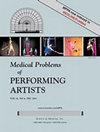马戏专业学院学生临床损伤负担:一项长达7.5年的纵向研究。
IF 0.7
4区 医学
Q3 MEDICINE, GENERAL & INTERNAL
引用次数: 2
摘要
目的了解马戏专业3年制大学生外伤的临床负担。方法从2009年8月至2016年12月的7.5年时间框架内,对来自现场诊所的学生(n=334)损伤数据进行检查。计算损伤发生率(每1,000训练小时),并检查临床发生率(损伤/年)与项目、性别、年龄和马戏团纪律的年份相关。每周和每月的损伤发生率与学校训练年度的里程碑相关。临床负担(损伤发生率和持续时间)根据解剖部位和马戏学科进行检查。结果总损伤发生率为1.89例/ 1000训练小时,持续时间超过4周的损伤发生率为0.94例/ 1000训练小时。临床发病率随治疗年限的增加而降低(p<0.05),且无性别和年龄差异。时间分析显示,在寒暑假归来后的3周内,每周损伤发生率升高(p<0.01),在技术考试前的几周内,每周损伤发生率升高(p<0.01)。从解剖位置上看,肩关节损伤是最大的临床负担,其次是踝关节损伤;从学科上看,地面杂技演员的临床负担最大,其次是带装备的地面杂技演员。结论马戏训练项目的整体损伤发生率在其他马戏训练项目和类似艺术、运动训练项目报道的范围内。资源应用于提高康复效果和预防肩部和踝关节损伤,并用于装备和传单的地面杂技演员。应研究提高假期后重返培训时安全性的预防性策略。本文章由计算机程序翻译,如有差异,请以英文原文为准。
Clinical Burden of Injuries in Students at a Professional Circus College: A 7.5-Year Longitudinal Study.
OBJECTIVE
To characterize clinical burden of injuries incurred by circus students enrolled in a 3-year college training program.
METHODS
Student (n=334) injury data derived from an in situ clinic was examined over a 7.5-year time frame from August 2009 to December 2016. Injury incidence rate (per 1,000 training hours) was calculated and clinical incidence (injuries/year) was examined in relation to year in program, sex, age, and circus discipline. Weekly and monthly injury incidence were plotted with respect to milestones in the scholastic training year. Clinical burden (injury incidence and duration) was examined according to anatomic location and circus discipline.
RESULTS
The overall injury incidence rate was 1.89 injuries/1,000 training hours and 0.94 injuries/1,000 training hours for injuries with a duration longer than 4 weeks. Clinical incidence decreased with year in program (p<0.05) and there were no sex or age differences. Temporal analysis demonstrated elevated weekly injury incidence for the 3 weeks following return from both summer and winter vacation (p<0.01) and for the weeks leading up to technical exams (p<0.01). According to anatomical location, shoulder injuries accounted for the greatest clinic burden followed by ankles and according to discipline, ground acrobat flyers followed by ground acrobats with equipment accounted for the greatest clinic burden.
CONCLUSION
Overall injury incidence rate in the circus training program was within the range reported by other circus training programs and similar artistic and athletic training programs. Resources should be designated for enhanced rehabilitation efficacy and prevention of shoulder and ankle injuries and for ground acrobats with equipment and flyers. Preventative strategies to improve safety upon return-to-training after vacations should be examined.
求助全文
通过发布文献求助,成功后即可免费获取论文全文。
去求助
来源期刊
CiteScore
1.60
自引率
22.20%
发文量
28
审稿时长
>12 weeks
期刊介绍:
Medical Problems of Performing Artists is the first clinical medical journal devoted to the etiology, diagnosis, and treatment of medical and psychological disorders related to the performing arts. Original peer-reviewed research papers cover topics including neurologic disorders, musculoskeletal conditions, voice and hearing disorders, anxieties, stress, substance abuse, and other health issues related to actors, dancers, singers, musicians, and other performers.

 求助内容:
求助内容: 应助结果提醒方式:
应助结果提醒方式:


